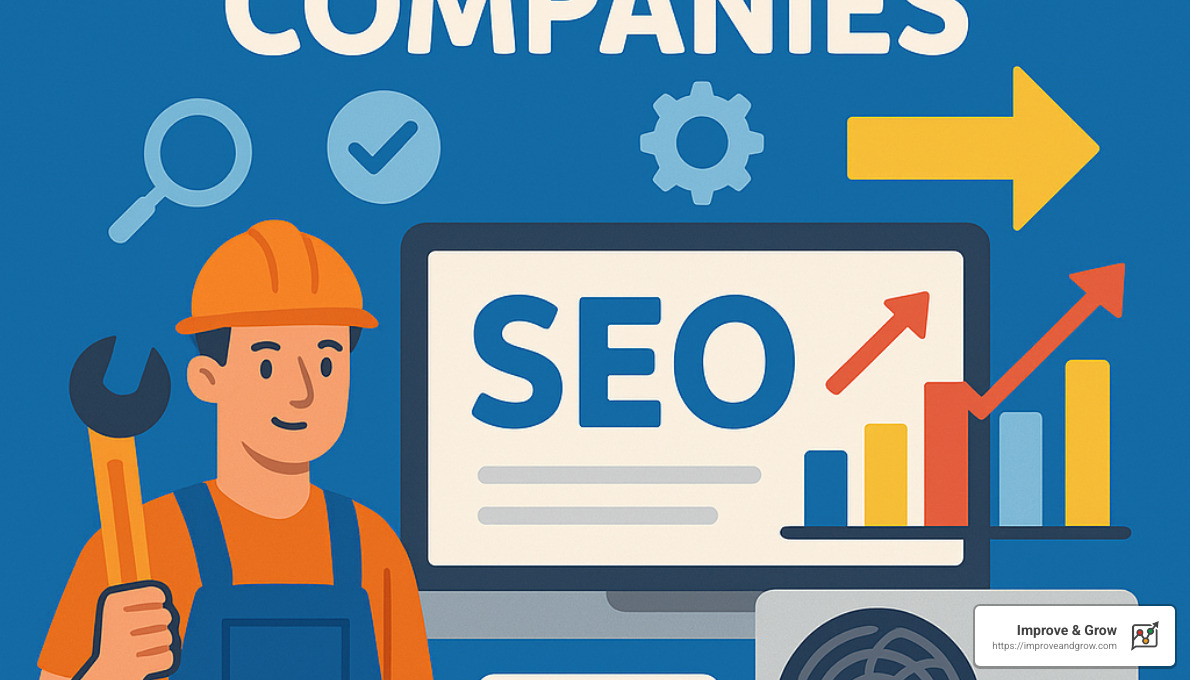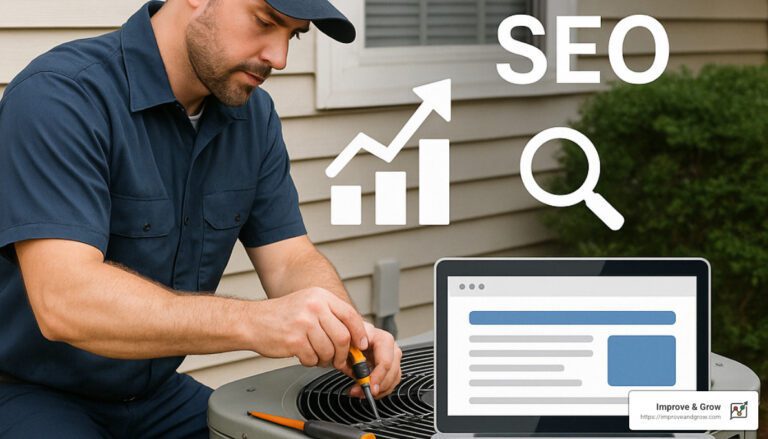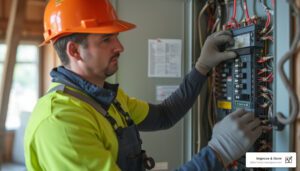Heating Up Your Online Presence: The Power of Local Visibility
SEO for HVAC companies transforms how heating and cooling businesses connect with local customers. It’s the art and science of making your business visible when homeowners need you most. Picture this: when a family’s AC fails during a heatwave, 97% will immediately grab their phones and search for help. If your business appears in those crucial moments, you win new customers – if not, your competitors do.
“In the HVAC industry, online visibility isn’t just important—it’s essential for survival. The more targeted website traffic you generate, the more qualified leads you’ll capture,” notes industry research.
What makes HVAC SEO so powerful is its ability to deliver high-intent leads who are actively seeking exactly what you offer. As Scott Rehnberg, SEO & Content Specialist at Improve & Grow explains, “SEO leads are eight times likelier to convert than traditional advertising leads. For HVAC companies specifically, appearing when homeowners are actively searching creates an immediate opportunity to solve their urgent problems.”
Unlike paid ads that stop working the moment you stop paying, SEO for HVAC companies builds a sustainable pipeline of organic leads that continues growing over time. The return on investment increases as your online presence strengthens.
HVAC SEO Essentials at a Glance:
| SEO Component | What It Does | Why It Matters |
|---|---|---|
| Local SEO | Optimizes for “near me” searches | 60% of all searches are on mobile devices |
| Google Business Profile | Helps you appear in Map Pack | Majority of local customers check Map results |
| On-Page Optimization | Makes your website relevant to searches | Helps Google understand your services |
| Content Strategy | Establishes expertise and authority | Builds trust with potential customers |
| Technical SEO | Ensures website loads quickly | 25% abandon sites that take >4 seconds to load |
| Reviews | Builds credibility | 90% of consumers read reviews before contacting |
The modern HVAC customer journey almost always begins online. Homeowners research solutions, compare companies, and make contact decisions all from their smartphones or computers. With 75% of searchers never scrolling past the first page of results, your visibility directly impacts your bottom line.

The beauty of SEO for HVAC companies is that it works while you sleep. Your optimized website, Google Business Profile, and content continue attracting leads 24/7, creating a reliable foundation for business growth. According to recent research from HubSpot’s local search statistics, 46% of all Google searches have local intent—people looking for services in their immediate area.
Ready to explore more about growing your HVAC business online? Check out these related resources:
The right SEO approach doesn’t just bring traffic—it brings the right customers at the right time, when they’re ready to book service calls and make purchasing decisions. By focusing on local visibility, you create a direct path from customer need to your phone ringing.
Understanding SEO for HVAC Companies: Fundamentals
The foundation of effective SEO for HVAC companies starts with understanding how people search for your services. Search engines like Google have evolved to prioritize user intent, meaning they try to understand what the searcher really wants rather than just matching keywords.
“Google’s recent updates, particularly the Helpful Content Update, have shifted the focus toward content that demonstrates Experience, Expertise, Authoritativeness, and Trustworthiness—or E-E-A-T,” explains Carl Lefever, Founder & Digital Marketing Strategist at Improve & Grow. “For HVAC businesses, this means providing genuinely helpful information that showcases your industry knowledge.”

The numbers tell a compelling story: 97% of consumers learn about local businesses online before making contact, and 75% of searchers never scroll past the first page of results. With such high stakes, understanding search behavior becomes crucial for capturing those potential customers. Recent research on local search shows that local service businesses like HVAC companies have tremendous opportunity to connect with high-intent customers through strategic SEO.
Types of HVAC Keywords & Intent
When homeowners need heating or cooling services, they search in different ways depending on where they are in their journey. Each type of search reveals something about their needs and how close they are to making a call.
Informational keywords show people looking to learn, not necessarily buy. A homeowner searching “why is my AC making a buzzing sound” or “how often should I change my furnace filter” isn’t immediately ready to hire you—but they’re identifying a problem. Creating helpful content for these searches establishes your expertise early in their decision process.
Commercial keywords indicate someone getting closer to hiring. They might search “best HVAC companies in Lancaster” or “cost of furnace replacement.” These folks are actively comparing options and pricing, making them warmer leads who need convincing that you’re the right choice.
Transactional keywords signal immediate need and high intent to purchase. “Emergency AC repair near me” or “same-day furnace service” means someone has a problem that needs solving right now. These are your hottest leads.
“The magic happens when you match your content to the customer’s search intent,” notes Brian Welch, Digital Marketing Strategist at Improve & Grow. “An emergency repair page should speak directly to solving immediate problems, while a maintenance guide can take a more educational approach.”
Local modifiers make all the difference for HVAC businesses. Phrases like “in [city name],” “near me,” or even specific zip codes transform generic searches into location-specific ones that match your service area. For example, “furnace repair in Lancaster County” is much more valuable to you than a generic “furnace repair” search from someone across the country.
SEO for HVAC Companies and Lead Generation
When it comes to filling your calendar with quality jobs, not all leads are created equal. SEO for HVAC companies stands out as a particularly powerful lead generation channel for several reasons.
First, organic search leads typically have a higher close rate than other marketing channels. When someone finds you through a specific search like “heat pump installation expert,” they’re actively seeking exactly what you offer—not just scrolling past an interruption-based ad.
The economics make sense too. While PPC campaigns in the HVAC industry can cost $20-50 per click in competitive markets, organic traffic has no per-click cost. Yes, there’s upfront investment in optimization, but once you’re ranking well, those leads keep coming without additional per-click fees.
What makes SEO particularly valuable for HVAC businesses is the self-qualification factor. Someone searching “emergency AC repair in Philadelphia” has already told you three critical things: they need AC repair, they need it urgently, and they’re in your service area. Compare that to someone who sees a general brand awareness ad while scrolling social media—they might not even own a home!
The trust factor shouldn’t be underestimated either. When homeowners see your business ranking organically on Google’s first page, it automatically builds credibility. They perceive your company as established and authoritative in a way paid ads simply can’t match.
While SEO takes longer to build than paid advertising, the compound effect creates an asset that continues generating leads without the ongoing per-click costs of PPC. For HVAC companies focused on sustainable growth and predictable lead flow, a strategic SEO approach delivers best long-term value and return on investment.
On-Site Optimization & Content Strategy
The cornerstone of SEO for HVAC companies is a well-optimized website that clearly communicates your services to both search engines and potential customers. Your website needs to be structured in a way that makes it easy for Google to understand what you offer and where you offer it.

On-Page SEO for HVAC Companies
Think of your website as your digital storefront. Just as you’d organize your physical shop to help customers find what they need, your website needs thoughtful organization for both visitors and search engines.
Creating dedicated service pages for each core offering—AC installation, furnace repair, duct cleaning—gives you powerful real estate to target specific keywords. These pages aren’t just listings; they’re opportunities to showcase your expertise for each service you provide.
“When optimizing HVAC service pages, aim to exceed your competitors’ content length by about 500 words while maintaining quality,” advises Scott Rehnberg, SEO & Content Specialist at Improve & Grow. “Search engines reward comprehensive content that thoroughly answers user questions.”
Your title tags are like digital billboards—they need to capture attention while clearly stating what you offer. Including your primary keyword and location (e.g., “24/7 Emergency AC Repair in Philadelphia | Company Name”) helps both users and search engines understand your page instantly.
The header structure of your pages matters tremendously. Use H1 tags for your main page title and H2/H3 tags for subheadings, incorporating relevant keywords naturally. This creates a logical hierarchy that makes content scannable for humans and parsable for search engines.
Don’t overlook your meta descriptions—these 150-160 character snippets are your chance to convince searchers to click. Include your target keywords and a compelling call to action that addresses the searcher’s needs.
Schema markup might sound technical, but it’s essentially a way to label your content for search engines. Implementing LocalBusiness and Service schema helps Google understand exactly what services you offer and where you’re located—critical for local HVAC businesses.
Adding FAQ sections to your service pages serves multiple purposes: they address common customer concerns, target long-tail keywords, and potentially earn featured snippets in search results—those coveted position-zero spots above regular listings.
For image optimization, convert your photos to webp format for faster loading, use descriptive file names, and include keyword-rich alt text. This helps search engines understand your visual content while improving accessibility.
Content Marketing with SEO for HVAC Companies
Content marketing goes beyond basic service pages to establish your expertise and attract potential customers throughout their buying journey—from early research to urgent needs.
Creating topic clusters is particularly effective for HVAC companies. Start with a comprehensive pillar page about a broad topic like “Complete Guide to Home HVAC Systems,” then build supporting content that links back to it—articles on choosing the right AC unit size, recognizing furnace replacement signs, or understanding energy efficiency ratings.
“The key to content marketing for HVAC companies is consistency,” explains Carl Lefever, Founder & Digital Marketing Strategist at Improve & Grow. “A content calendar that addresses seasonal topics ahead of peak demand periods helps you capture search traffic when homeowners are actively looking for solutions.”
Seasonal content resonates powerfully with homeowners. Winter furnace maintenance tips in fall or AC preparation guides in spring put you in front of customers right when they’re thinking about these issues. This timing alignment significantly increases engagement and conversion potential.
Developing educational guides establishes your authority in the space. Deep dives into topics like “Understanding HVAC Energy Efficiency Ratings” or “Complete Homeowner’s Guide to Heat Pumps” demonstrate your expertise while answering questions homeowners might not even know to ask.
Don’t forget the importance of local content. Articles specific to your service area—like “Common HVAC Problems in Older Philadelphia Homes” or “How Lancaster County’s Climate Affects Your HVAC Needs”—connect with local homeowners in a way generic content never could.
Video content deserves special attention in your HVAC marketing strategy. Simple demonstrations of maintenance tips, explanations of how systems work, or introductions to your team can be repurposed across your website, YouTube channel, and social media platforms.
With Google’s Helpful Content Update, the focus is firmly on creating content for humans first, search engines second. This means providing genuinely helpful information that showcases your expertise rather than keyword-stuffed articles with little practical value. For more detailed strategies, check out our guide on SEO for Home Service Contractors.
Effective SEO for HVAC companies means creating a content ecosystem where each piece works together—service pages that convert, blog posts that educate, videos that demonstrate, and all optimized to be found exactly when homeowners need your services most.
Local Visibility: Google Business Profile & Citations
For HVAC SEO, local visibility isn’t just important—it’s absolutely essential. Why? Because when homeowners need their AC fixed or furnace replaced, they’re looking for someone nearby who can help them fast. The cornerstone of your local visibility strategy should be your Google Business Profile (GBP), the powerful tool that helps you appear in that coveted “Map Pack” at the top of local search results.

“The Map Pack is prime real estate for HVAC companies,” explains Brian Welch, Digital Marketing Strategist at Improve & Grow. “It’s the first thing people see when searching for local services, and it includes exactly what they need: your rating, location, hours, and direct contact options. Missing out on this visibility means missing out on your most qualified leads.”
Optimizing a Google Business Profile for HVAC Companies
Your GBP often creates the crucial first impression that determines whether a potential customer calls you or your competitor. Here’s how to make yours shine:
Start by claiming and verifying your listing—this gives you control over what potential customers see. Then, fill out every single section of your profile completely. This includes selecting “Heating and Air Conditioning Contractor” as your primary category and adding relevant secondary categories like “Furnace Repair Service” or “Duct Cleaning Service.”
Your business description should clearly highlight your main services and service areas, while your service menu should list everything you offer with detailed descriptions. Be meticulous about adding all the cities and neighborhoods you serve, and keep your hours accurate—especially during seasonal changes when emergency calls might increase.
Visual elements matter tremendously. Add high-quality photos of your uniformed team, branded service vehicles, impressive before/after project results, and your physical location. Short videos demonstrating services or maintenance tips can help you stand out from competitors who only use static images.
Don’t forget to use Google Posts regularly. Share seasonal maintenance specials, announce new equipment or services, celebrate company achievements, and showcase customer success stories. These posts keep your profile fresh and engaging.
“Proximity is the number one ranking factor for Google Maps results,” notes Brian Welch. “While you can’t change your physical location, you can ensure your GBP is fully optimized to maximize visibility in the areas you serve.”
NAP consistency (Name, Address, Phone) is critical across all your online platforms. Your business information should be identical everywhere it appears—on your website, GBP, and all directory listings. Even small inconsistencies can confuse search engines and potentially hurt your rankings.
Reviews & Reputation Management
Online reviews have become incredibly powerful in the HVAC industry. Research shows that a whopping 90% of consumers read online reviews before contacting a business, making your reputation a major factor in whether your phone rings.
Request reviews systematically. The best time to ask is right after completing a successful service call when customer satisfaction is highest. Consider implementing an automated text or email system that makes it easy for happy customers to leave their feedback.
Respond thoughtfully to every review—both positive and negative. When customers see you engaging, they recognize you care about their experience. For positive reviews, a simple thank you acknowledges their support. For negative ones, a thoughtful, non-defensive response shows your commitment to making things right.
“Reviews aren’t just about SEO—they’re about building trust,” says Jen Leong, Digital Marketing Strategist at Improve & Grow. “When potential customers see that you’ve consistently delivered great service to others in their community, they feel confident choosing you over competitors with fewer or lower-quality reviews.”
Address negative feedback professionally and view it as an opportunity for improvement. As Bill Gates famously noted, “Your most unhappy customers are your greatest source of learning.” A thoughtful response to criticism often impresses potential customers more than a perfect 5-star record.
Showcase your best reviews on your website using schema markup. This extra technical step can help you earn rich snippets in search results, making your listings stand out with visible star ratings.
Beyond Google, maintain profiles on industry-specific platforms like Angi, HomeAdvisor, and Yelp. Many homeowners use multiple platforms when researching service providers, so being present across these sites expands your visibility.
Citations—mentions of your business name, address, and phone number on other websites—also play a crucial role in local SEO success. Focus on building citations on industry directories (ACCA, HomeAdvisor), local business directories (Chamber of Commerce, BBB), and general business directories (Yelp, Yellow Pages). Consistent NAP information across all these citations strengthens your local search presence and helps more customers find you when they need you most.
Learn more about generating HVAC leads with Google Business Profile
Authority Building: Backlinks, Social Signals & PR
While on-site optimization and local listings form the foundation of SEO for HVAC companies, authority signals from external sources significantly influence your rankings. Backlinks—links from other websites to yours—remain one of Google’s most important ranking factors.

Link-Building Tactics for SEO for HVAC Companies
Quality trumps quantity when it comes to backlinks. Think of link building as establishing your company’s reputation in the community – each quality link acts as a vote of confidence from another trusted source.
“Link building is like forging alliances with powerful kingdoms,” explains Scott Rehnberg. “Each quality link from a relevant, authoritative site signals to Google that your business is trustworthy and credible in the HVAC space.”
Local business partnerships offer a natural starting point for HVAC companies. Consider reaching out to complementary businesses like realtors, home inspectors, or electricians for mutual referrals. These relationships can lead to valuable backlinks and a steady stream of referral business.
Community involvement pays dividends beyond just good PR. By sponsoring local events, sports teams, or charities, you’ll not only earn links from their websites but also potentially gain coverage from local news outlets. We’ve seen HVAC clients transform a $500 youth baseball team sponsorship into multiple high-quality backlinks and increased brand recognition.
Don’t overlook the power of industry associations. Joining organizations like your local HVAC contractors’ association or Chamber of Commerce typically includes a member listing on their website – an easy win for relevant backlinks. The Better Business Bureau (BBB) profile is particularly valuable as it’s highly trusted by both consumers and search engines.
Sometimes, your brand gets mentioned online without a link. Tools like Google Alerts can help you find these unlinked mentions, allowing you to reach out and request that the publisher add a hyperlink to your website. This simple tactic can turn existing brand mentions into valuable ranking signals.
For HVAC companies serving multiple locations, geo-tagged photos and check-ins create additional local relevance signals. Some of our clients use tools like DataPins to systematically create location-specific content that reinforces their service area coverage to search engines.
Social & Video Amplification
While social media signals don’t directly impact search rankings, they play a crucial supporting role in your overall SEO for HVAC companies strategy. Think of social platforms as amplifiers for your content and brand messaging.
Facebook tends to be the most effective platform for HVAC companies, particularly for reaching homeowners over 35. The platform’s robust targeting options make it ideal for promoting seasonal maintenance specials or emergency services during extreme weather.
Instagram works well for showcasing your team and completed projects. Before-and-after photos of installations or repairs help potential customers visualize your quality work. Adding location tags to these posts reinforces your service area for local searchers.
YouTube deserves special attention in your strategy. As the second-largest search engine after Google, optimizing your video content can help you appear in both YouTube and Google search results. Consider creating short, helpful videos addressing common HVAC questions like “Why is my furnace making that noise?” or “How often should I change my air filter?”
The beauty of video content is its versatility. A single 5-minute maintenance tutorial can be repurposed into multiple social media clips, embedded on your website’s service pages, included in email newsletters, and featured in blog posts – all while building your authority and driving traffic from different sources.
Consistency matters across all platforms. Make sure your business name, address, phone number, and branding elements remain identical across every social profile and directory listing. This consistency reinforces your NAP information for local search algorithms while creating a cohesive brand experience for potential customers.
Technical Performance, Measurement & FAQs
The technical foundation of your website significantly impacts your SEO for HVAC companies success. Search engines favor websites that provide excellent user experiences, particularly on mobile devices.

Technical SEO for HVAC Websites
Your website’s technical performance is like your HVAC company’s service vehicle – if it breaks down, you can’t reach customers. Let’s look at what keeps your digital engine running smoothly.
Page speed matters more than you might think. When 40% of visitors abandon websites that take more than three seconds to load, you can’t afford to keep potential customers waiting. This is especially true for emergency situations – imagine someone with a broken AC in July waiting for your slow website to load. They’ll likely hit the back button and call your competitor instead.
“For HVAC companies, website speed is particularly important because many searches happen during emergency situations,” explains Ricky Angeles, Systems Manager at Improve & Grow. “A potential customer with a broken AC in summer won’t wait for a slow website to load.”
Improve your site speed by compressing images, minifying code, implementing browser caching, using a content delivery network, and considering premium hosting for your site.
Mobile-first design isn’t optional anymore. With 60% of searches now happening on mobile devices, Google prioritizes the mobile version of your site when determining rankings. Your website must look great and function perfectly on smartphones – that’s where most of your emergency calls will come from.
Core Web Vitals are Google’s metrics for measuring user experience. These include loading performance (how quickly content appears), interactivity (how quickly your site responds to user input), and visual stability (elements not shifting around while loading). Use PageSpeed Insights to check your site’s performance and identify issues that need fixing.
Secure connections build trust with both Google and your visitors. Having HTTPS encryption through an SSL certificate is now a standard expectation. Without it, browsers will warn visitors that your site isn’t secure – hardly the impression you want to make when asking for their business.
Crawlability ensures search engines can find and index all your content. Create a logical site structure with clear navigation, implement an XML sitemap, use robots.txt appropriately, and create clean, descriptive URLs that include key service terms.
Tracking Success & Continuous Improvement
If you can’t measure it, you can’t improve it. Tracking the right metrics helps you understand what’s working and what needs adjustment in your SEO for HVAC companies strategy.
Google Analytics gives you insights into your website traffic – how many visitors you’re getting, which pages they’re viewing, how long they stay, and what actions they take. Setting up conversion tracking for phone calls, form submissions, and chat engagements helps you see which marketing channels deliver actual leads.
Google Search Console is your early warning system for technical problems. It shows which keywords are bringing visitors to your site, identifies indexing issues, and alerts you to mobile usability problems that could hurt your rankings.
Call tracking helps you connect the dots between your online presence and phone leads. By using unique phone numbers for different marketing channels, you can attribute calls to specific sources – whether they came from organic search, paid ads, or directory listings.
Beyond just tracking website visitors, smart HVAC companies measure conversion rates (the percentage of visitors who become leads), lead quality (how many leads turn into actual jobs), and ultimately, return on investment from their marketing efforts.
“The most successful companies we work with review their SEO metrics monthly and make data-driven adjustments,” says Carl Lefever. “This continuous improvement approach leads to steadily increasing performance over time.”
Frequently Asked Questions about SEO for HVAC Companies
How long until my HVAC company sees results from SEO?
SEO is a marathon, not a sprint. While you might see some improvements within weeks, significant results typically take 4-6 months. Local SEO elements like Google Business Profile optimization can show faster improvements (1-3 months), while competitive keyword rankings may take 6-12 months to achieve. The good news? Unlike paid advertising that stops when you stop paying, SEO builds lasting value over time.
What budget should I allocate for HVAC SEO?
Most HVAC companies invest between $1,000-$5,000 monthly in SEO, depending on market size and competition. In smaller markets, starting at $1,000-$2,000 monthly can yield good results, while competitive metropolitan areas may require $3,000-$5,000+ monthly. SEO is an investment that builds value over time, not an expense.
Can I do SEO for my HVAC company myself, or should I hire an expert?
While basic local SEO elements like Google Business Profile optimization can be managed in-house, comprehensive SEO requires specialized knowledge and tools. Most successful HVAC companies either partner with an experienced digital marketing agency or dedicate an internal resource with SEO expertise. The algorithms change constantly, and keeping up with best practices is a full-time job.
How does SEO complement paid advertising for HVAC companies?
Think of SEO and paid advertising as partners, not competitors. Paid ads provide immediate visibility while SEO builds long-term organic presence. Many HVAC companies allocate 60% of their digital marketing budget to paid advertising for quick leads and 40% to SEO for sustainable growth. This balanced approach ensures you’re capturing both immediate needs and building for the future.
What are the biggest SEO mistakes HVAC companies make?
The most common mistakes include keyword stuffing (overusing keywords unnaturally), buying low-quality backlinks that can trigger penalties, creating duplicate content across service area pages, neglecting mobile optimization, failing to track and measure results, ignoring Google Business Profile, and overlooking technical website issues like slow loading speeds.
“The most successful HVAC companies view SEO not as a one-time project but as an ongoing business development strategy,” explains Scott Rehnberg. “They consistently invest in their online presence, just as they would in equipment and training.”
By addressing these technical factors and consistently measuring your results, your HVAC company can build a strong digital foundation that generates leads for years to come. For more insights on ranking locally, check out our guide on how to rank on Google for local home service contractors.
Conclusion
Effective SEO for HVAC companies is no longer optional—it’s essential for business growth in today’s digital landscape. Throughout this guide, we’ve seen how combining local optimization, technical excellence, quality content, and authority building creates a sustainable system for generating qualified leads that keep your phone ringing.
The numbers tell a compelling story: 97% of people learn about local companies online, 75% never venture beyond the first page of search results, and SEO leads convert at significantly higher rates than traditional marketing methods. For your HVAC business, this translates to a steady stream of high-intent customers actively searching for exactly what you offer.
“What makes SEO particularly valuable for HVAC companies is its scalability and compounding returns,” notes Carl Lefever of Improve & Grow. “Unlike paid advertising that stops working when you stop paying, SEO builds an asset that continues to generate leads over time, often with improving results as your authority grows.”
The most successful HVAC companies approach SEO as a strategic investment rather than a marketing expense. They understand that building online visibility works much like building a reputation in their community—it takes time and consistent effort, but the rewards are substantial and long-lasting.
SEO for HVAC companies works best when viewed as a growth system rather than a one-time project. Your digital presence becomes stronger each month, gradually reducing your cost-per-lead while increasing the quality of prospects. Many of our HVAC clients report that their organic search leads close at nearly twice the rate of other marketing channels because these customers have already researched their options and chosen to contact you specifically.
Whether you’re just starting your SEO journey or looking to improve your existing strategy, the principles outlined in this guide provide a clear roadmap to sustainable growth. By focusing on the specific needs and search behaviors of your local market, you create a digital presence that not only attracts leads but converts them into loyal, long-term customers.
Ready to lift your HVAC company’s online presence and generate more qualified leads? Learn more about our contractors & trades marketing services designed specifically for businesses like yours.
In the competitive HVAC industry, the companies investing in building their online visibility today will be the ones thriving tomorrow. The question isn’t whether you can afford to invest in SEO—it’s whether you can afford not to.




